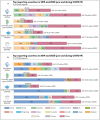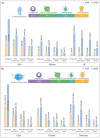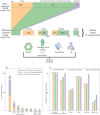Environmental Impacts of Personal Protective Clothing Used to Combat COVID- 19
- PMID: 34901387
- PMCID: PMC8646872
- DOI: 10.1002/adsu.202100176
Environmental Impacts of Personal Protective Clothing Used to Combat COVID- 19
Abstract
Personal protective clothing is critical to shield users from highly infectious diseases including COVID-19. Such clothing is predominantly single-use, made of plastic-based synthetic fibers such as polypropylene and polyester, low cost and able to provide protection against pathogens. However, the environmental impacts of synthetic fiber-based clothing are significant and well-documented. Despite growing environmental concerns with single-use plastic-based protective clothing, the recent COVID-19 pandemic has seen a significant increase in their use, which could result in a further surge of oceanic plastic pollution, adding to the mass of plastic waste that already threatens marine life. In this review, the nature of the raw materials involved in the production of such clothing, as well as manufacturing techniques and the personal protective equipment supply chain are briefly discussed. The environmental impacts at critical points in the protective clothing value chain are identified from production to consumption, focusing on water use, chemical pollution, CO2 emissions, and waste. On the basis of these environmental impacts, the need for fundamental changes in the business model is outlined, including increased usage of reusable protective clothing, addressing supply chain "bottlenecks", establishing better waste management, and the use of sustainable materials and processes without associated environmental problems.
Keywords: COVID‐19; environmental impact; personal protective equipment; plastic pollution; protective clothing; sustainability.
© 2021 The Authors. Advanced Sustainable Systems published by Wiley‐VCH GmbH.
Conflict of interest statement
The authors declare no conflict of interest.
Figures








References
-
- Singh N., Tang Y., Ogunseitan O. A., Environ. Sci. Technol. 2020, 54, 8500. - PubMed
-
- WHO , Virtual press conference on COVID‐19, World Health Organization, Virtual Conference, Geneva: 2020.
-
- Kilinc F. S., J. Eng. Fibers Fabr. 2015, 10, 155892501501000313.
Publication types
LinkOut - more resources
Full Text Sources
